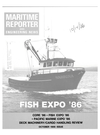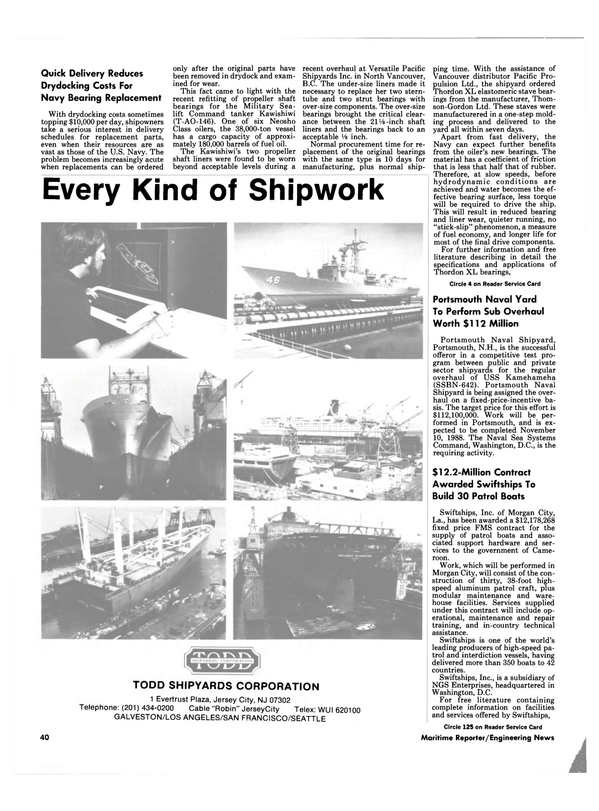
Innovative Shortsea Vessel Fitted With Unique MacGregor-Navire CAE
MacGregor-Navire (MGN), the leading designer of cargo access equipment (CAE), has supplied the innovative shortsea RO/LO vessel Alster Rapid with a shipset of CAE that for originality and the mix of cargo made possible by its use, must stamp it as unique. The 2,515-dwt vessel, though small, is equipped so that it offers the cargo-handling capabilities of ships much larger.
The recently delivered Alster Rapid was built by the Hamburg yard of J.J. Sietas for the West German owner Henry Stahl, who immediately deployed the vessel in his U.K.-trading Washbay Line.
The new ship will form part of a thrice-weekly service operated by the line for more than 20 years.
All four of the vessel's cargo decks above the tanktop level are entirely composed of removable flush-fitting panels. Each level, in fact, is a stowable MGN hatch cover that completely spans the hull to constitute a deck. Each deck includes an individual panel (or panels) that also does duty as interdeck ramps.
When the cargo to be loaded requires the removal of any deck, the panels of which it is formed can be rolled into stowage and stacked, both movements being performed automatically ; the only exception is the four panels on the forward part of the upper deck, which fold into stowage. Replacement of a deck is also automatic, the unstacking and rolling (and unfolding) being performed in reverse order.
Long cargo (up to about 148 feet) can be loaded vertically using shoreside cranes but the principal mode of access is horizontal, cargo being rolled over the stern via a 200-toncapacity ramp that, in keeping with the singular nature of all this ship's CAE, is adjustable in length, width, and height. Width and height adjustment were included to cater for specific berthing conditions at ports on the destined routes; height adjustment, in which the ramp can be hinged at any one of the four decks above the tank top, enables the ship to be worked at any quay height or tidal level, thus eliminating the need for link span berthing.
Another unusual feature of the Alster Rapid, which the MGN access equipment is designed to facilitate, is its ability to load fiat-bottomed floating cargo such as small barges, these being floated/winched aboard through the stern in what the owner calls the slip-on/slip-off (SO/SO) mode. For this operation, one of the main deck panels is placed athwartships (there is a 5- ton crane fitted aft for this purpose) to form a watertight bulkhead located about 59 feet forward of the stern ramp, thus creating a separate section. For embarking floating cargo, the stern ramp is lowered to an angle of —20 degrees below the horizontal, its end reaching about 10 feet below the waterline. This exposure of the stern—the so-called "open air" section—also enables the loading of cargo of unlimited height when the upper deck panels within the sternmost section are removed.
Flexibility in cargo operations is greatly enhanced by the multiangled ramp situated within the 59- foot-long sternmost section. This ramp, the two ends of which are separately height-adjustable by means of four jigger winches, is used as an extension or continuation of the external stern ramp. This facility, together with ramps on the main and weather decks (which may or may not have to be brought into use), permits direct access for wheeled cargo to any deck. The criteria for use of the main/weather deck ramps will depend on the gradient to be climbed, which in turn is determined by the quay height.
The Alster Rapid has an overall length of 290.6 feet, beam of 46.9 feet, depth to main deck of 16.6 feet, and draft of 16.7 feet. Propulsion is provided by a MAN B&W 8L 28/ 32-FVO diesel engine with an output of 1,530 bhp, giving a speed of 13 knots.
For complete literature fully describing all MacGregor-Navire equipment, Circle 66 on Reader Service Card
Read Innovative Shortsea Vessel Fitted With Unique MacGregor-Navire CAE in Pdf, Flash or Html5 edition of October 1986 Maritime Reporter
Other stories from October 1986 issue
Content
- Wartsila Diesel Acquires Lindholmen Motor page: 5
- Bethlehem Yard Receives $1.9-Million Contract To Repair RRF Reefer page: 5
- 'World Series Contactors And Overload Relays' Brochure Available page: 6
- Bakke New President Of Hempel Coatings (USA) page: 6
- Charles W. Mann Named President, MonArk Boat page: 7
- Bath Iron Works Sold To New York Investor Group page: 8
- SPT Ltd. Offers Free 14-Page Color Brochure On Sound Powered Phones page: 8
- San Diego Shipbuilding Delivers Dinner Cruise Vessel To Bahia Resort page: 8
- Bethlehem-Sparrows Point Receives Navy Contracts Worth $5.1 Million page: 9
- Keel-Laying Ceremony Held At Bethlehem-Sparrows Point Yard For First of Two Navy Survey Vessels page: 9
- Hempel Begins New Campaign page: 9
- Sperry Appoints New Program Manager page: 10
- Volvo Penta's New 61 And 71 Series For Workboats Developed Using Advanced Computer Techniques page: 10
- Falmouth Shiprepair Offers Free Color Brochure On Facilities And Services page: 11
- Master Marine Responds To Change In The Shipbuilding Market With Vessel Conversions page: 11
- Newport News Yard Lays Keel For Carrier 'George Washington' page: 11
- FISH EXPO '86 20th Anniversary Preview page: 12
- New MAN B&W Diesel Engine Extends Two-Stroke Output To Lower Range page: 18
- Avondale To Perform Major Work On The Wisconsin (BB 64) page: 18
- Ulstein Introduces New High-Lift Type Rudder page: 19
- Marinette Marine Awarded $51.8-Million Navy Contract To Build Another MCM page: 20
- Raytheon Signs Sales Agreement With YEW page: 20
- Deck Machinery Ana Cargo-Handling Equipment — A Review— page: 22
- Drewry Predicts Growing Demand For Larger Products Carriers page: 35
- Kamatics Offers New Free 22-Page Catalog On KAron® Bearings page: 35
- Squire-Cogswell To Distribute Robuschi Liquid Ring Vacuum Pumps In U.S. And Canada page: 36
- 12-Page, Full-Color Brochure From Bailey Highlights Marine Control Systems And Services page: 36
- Rolls-Royce Designed Marine Diesels Make U.S. Debut In New Catamaran page: 37
- Innovative Shortsea Vessel Fitted With Unique MacGregor-Navire CAE page: 38
- Cummins-Powered River Queen Delivered By Serodino Shipyard page: 38
- Claremont Offers Free Catalog On Thermal & Acoustical Insulation page: 39
- Quick Delivery Reduces Drydocking Costs For Navy Bearing Replacement page: 40
- $12.2-Million Contract Awarded Swiftships To Build 30 Patrol Boats page: 40
- Peterson Gets $96.6-Million Navy Contract To Build Two Additional MCMs page: 41
- Tideland Introduces New Buoy Design For Deepwater Applications page: 41
- Canadian Offshore Resources Exposition page: 42
- Spinner II Oil Cleaning Centrifuges Reduce Engine Wear Rates page: 44
- Nichols Delivers Another Passenger Catamaran To Red & White Fleet page: 45
- Hyundai Introduces Three Standard Crude Oil Tanker Designs page: 45
- Columbian CF-3 Stainless Propellers Provide High Performance And Long Life page: 46
- Gladding-Hearn Builds Lobster Boat For New Hampshire Firm page: 46
- Drew And MAN B&W Conduct Joint Tests On Fuel Additive page: 47
- PACIFIC MARINE EXPO page: 48
- Fairbanks Morse Supplying Emergency Power For Sohio Drilling Facility In Alaska page: 52
- New GRP Survival Lifeboats From OME Withstand 1,000° C page: 52
- Marathon LeTourneau Awarded Contract To Convert Rig page: 53
- Racal's ISES Improves Ship Operating Efficiency page: 59
- Pittsburgh Brass Offers Free Catalog On Valves And Actuators page: 59
- Free 12-Page Brochure Highlights Avondale's Seven Divisions page: 59
- More Than 500 Vessels Now Coated With Jotun Seaconomy page: 62
- American Ship Awards Contract For Preliminary Passenger Ship Design page: 63
- Free Eight-Page Brochure On Marine Powermeters Offered By Acurex page: 63


